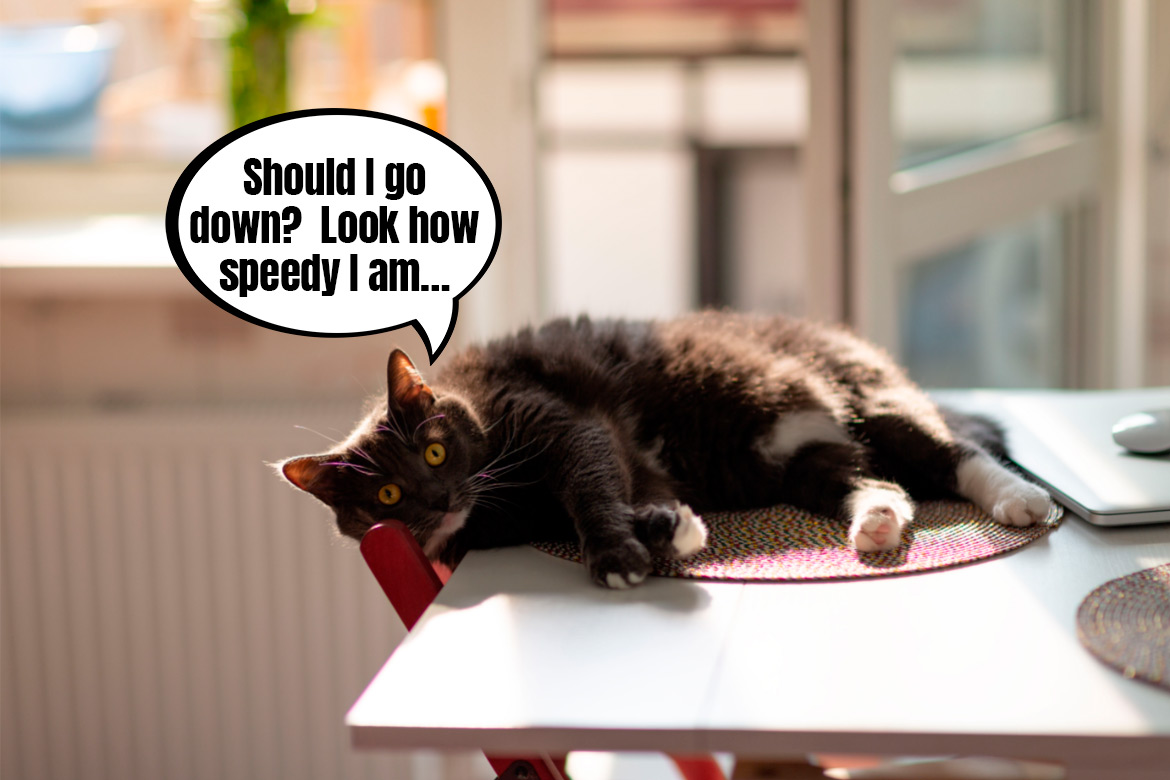Cats and bans? This can’t work out. Our furs love to walk their own paths and it also translates to their everyday domestic lives. Lead by curiosity, they will gladly visit your kitchen counters, check the durability of your new curtains, test out the quality of furniture upholstery and taste test the ferns around the house, just as a desert. We, as Carers, would obviously prefer them not doing all that. But how to train a cat to stop their unwanted behavior? Let’s find out, fabCats.
Unwanted behavior vs cat nature
For starters, let’s get the definition of an unwanted behavior right. It includes all cat behaviors that we, Carers, see as unacceptable and want to stop completely or change them to be less destructive. In this bag, we’ll find stuff like jumping on the countertops, eating plants, scratching couches and carpets, digging in plant pots, attacking and aggression towards the hoomans or stealing food from the table. We dare to say that every cat Carer will find some behavior their cat could work on.
What connects all the unwanted behaviors we mentioned here? It’s cat nature, obviously! Their curiosity of the world and the need to explore everything can lead a cat into places that their Carers would prefer not to see them at. Some of those behaviors are the result of natural cat needs – scratching, biting or hunting are at the core of their daily lives. And though we can work on many of them so that both we and the cat are happy, at the end of the day we have to remember one thing – by inviting a cat to live with us, we take a compromise with a being who, just like us, have their needs, requirements and expectations. If the cat is supposed to conform to living with us, we have to be ready to conform ourselves to live with a cat as well.
Praise, don’t punish – eliminating unwanted behaviors in cats
Cat behavior can be shaped by strengthening good habits and slowly taking out the ones we consider to be unwanted. However, it’s not a simple system of praise and punishment because punishment doesn’t work well with felines. Cats cannot connect their behavior (which we see as unwanted) with the punishment that we administer – even the most gentle reprimand will be seen by a cat as the direct effect of their hooman’s behavior. If we take the most common example of spraying a cat with water, the cat won’t see it as: “I jumped up on the counter so the hooman sprayed me with water. I won’t do it again”. The cat will see our behavior as: “I was walking around the counter when the hooman, my hooman, decided to hurt me. I am losing my trust in them”.
The primary way of working on cat behavior should be to solidify their good behavior, show them alternative solutions and phase out the unwanted behavior in a way that is not a punishment, but rather a sign for the cat that the action doesn’t bring them the satisfaction they expected. When your cat chooses a scratcher over the couch – praise them with a snack. You can use clicker training or give out the snacks on their own, but remember that you have 2-3 seconds to react before the cat stops linking their good behavior with the treat. Can your reflexes handle that…:)
And what about unwanted behaviors and phasing them out? Here our actions should depend on the type of behavior and the goal we want to achieve. For example, if the problem is constant meowing and attention seeking, the most effective way is to ignore the cat. Why? If they don’t achieve what they wanted, they won’t get rewarded with us turning to them, they will not want to make the effort next time. And once they understand that their efforts and tricks don’t impress us, they will see them as a waste of time.
But what about behaviors like walking on the kitchen countertops (including – the worst! – walking on the cooker) or stealing food? In those cases the method will be a little different – ignoring the behavior is a reward in itself, as the cat gets our quiet permission to do whatever they want. “I’m on the counter and nobody’s shooing me off? Fantastic! I’ll stay here for longer”. When there’s no point in ignoring the behavior, let’s make sure the outcome of doing the bad thing doesn’t give the cat any satisfaction. Taking the kitchen counters as an example, you could try to put aluminum foil all over it as cats generally don’t like walking on it – once they jump up and see that the countertop not what they hoped for, they’ll quickly want to hop off it. And to compensate the cat for not being able to jump on the counters, we should set up a high scratcher nearby the kitchen and give the cat the ability to supervise everything that’s happening there anyway.
Provide the cat with valuable alternatives
Whenever you say “NO”, always give your cat access to a “YES” . It’s a simple rule that works during behavioral training for cats and gets great results in both eliminating unwanted behaviors and building a good relationship between a cat and their Carer. Behavioral training for cats is there to help cats pursue their natural needs and shape their behavior in a way that allows cats and hoomans to live happily side by side. As Carers we need to remember that scratching, marking, peeing or jumping on top of things is a part of cats’ nature and if we don’t provide them with a space to do all that, they will find their own ways.
Give your cat an interesting alternative to an unwanted behavior and let them live their happy cat life to the fullest. We say NO to scratching our furniture, but immediately furnish our house with cardboard scratchers that are attractive for all cats and much more pleasant to scratch than having to put your claws into hooman furniture. Also, scratching the scratchers won’t make hoomans unhappy. And if a cat jumps up on high shelves and pushes everything off them, we say NO to that, but rather than denying them the opportunity to get on a higher levels of the house, we build up a cat superhighway with shelves, scratchers and other surfaces that will let the cat move freely around the house without touching the floor. The cat will be happy being able to explore the vertical space of the house and we will be able to put our own things somewhere else where the furry alpinist won’t be interested in pushing them off.
Find out more on creating a cat superhighway – or a CATway in the myKotty slang – on our blog: https://blog.mykotty.pl/en/2021/03/22/strengthening-the-cat-territory-how-to-build-an-at-home-highway-for-your-kitties/
Unwanted behaviors vs health
Talking about cat behavior we can’t forget that some of the issues can be a result of different health problems which cats find their own way of dealing with. Through aggression, vocalization, peeing outside the litter box or destructive behaviors they are trying to ease the pain, release tension, kill boredom or get our attention. We should remember that a cat won’t tell us they’re in pain, but they will try to convey to us that something’s not right.
As an example here, let’s take peeing outside the litterbox. The cat doesn’t do it just to “show us” or “be mean” – the problem here is most often connected with urinary tract issues, stress, bad relationships with another cat living at home or a wrong type of cat litter or the litter box. When we react to finding a cat poop or pee outside the litter box, we shouldn’t be angry, mean or ready to punish the cat – we have to find the source of the issue first, take our cat to the vet and if the tests come out all good, take the matter to an experienced behaviorist. Pairing up with a specialist is always easier than working solo.
Does verbal praise work on a cat?
We shouldn’t shout at the cat, punish them physically or beat them up – it doesn’t work and isn’t good for the cat’s mental health or their relationship with us. However, verbal reactions are worth paying attention to because a confident NO paired with the techniques we mentioned before could cause the cat to connect the word “no” with us not wanting them to do something and react accordingly. Our verbal reprimand can go hand in hand with a gentle clap or finger snap that will draw the cat’s attention and enhance the unwanted nature of their behavior (but don’t mistake it for scaring the cat – never do that).
By analogy, for some cats, attention from their Carer is enough of a treat in itself and as the training proceeds it is possible to move the value of physical reward (the tasty treat) onto the verbal praise. By saying “good job!”, “you’re the best cat”, we can make some cats so happy, they will run towards us to get pets and be even closer to us.
The ability to understand cats and match our reactions and expectations to our own pets is definitely something every cat Carer should work on. This could make us and our furs live together happily and with no misunderstandings. And how do you, dear fabCats, deal with phasing out unwanted behaviors with your cats? And what offenses have they committed in their lives already? Sound off in the comments 🙂




